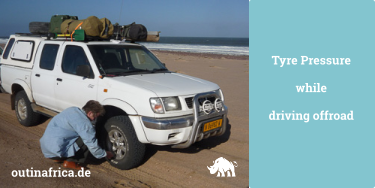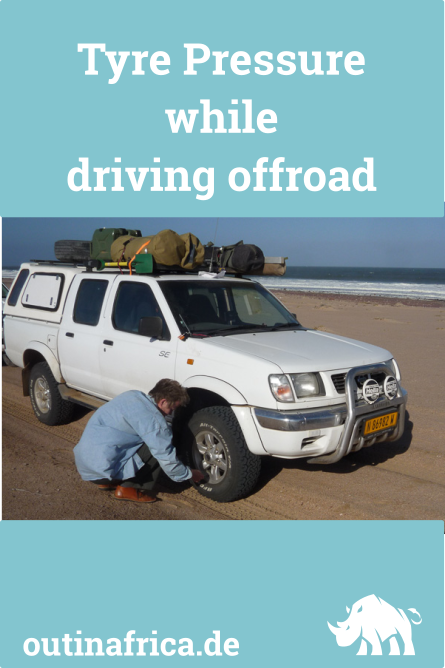This post is also available in:  Deutsch (German)
Deutsch (German)
Why should you adjust your tyre pressure while driving offroad?
It helps to adapt the tyre pressure of the car to the terrain while driving offroad. This adaption not only makes driving easier, but also safer. Which tyre pressure should you use in which terrain?

(Image by Bryn Pinzgauer auf Flickr)
We drive a Nissan NP300 Hardbody with BF Goodrich tyres. Depending on the terrain one should deflate or inflate the tyres. In the Internet one often reads, that you should deflate the tyres by a certain percentage of the pressure for tar roads as recommended by the manufacturer of the car.
Yesterday, Rudolf Mohrman postet the following recommendation in the Facebook group “Camping in Namibia”:
| Approximate Deflation | |
| Terrain | Percentage deflation |
| Tar | 0% (From manufacturer’s recommendation) |
| Gravel | 10-15% |
| Corrugated dirt | 10-15% |
| Sharp rocks | 10-15% |
| Smooth rocks | 10-15% |
| Mud | 25% |
| Sand | 50-60% |
The German offroad website “Pistenkuh” gives the following tips regarding tyre pressure while driving offroad:
Tyre pressure is crucial for the performance of the vehicle in the open country. Reducing the pressure of your tyres while driving offroad helps you more than you think. Especially beginners don’t believe this, and are afraid of deflating the tyres of their car. It is no joke: in extreme situations you can reduce the tyre pressure to 0,6 bar.
As reference value one can say to reduce the pressure of your tyres in offroad situations (sand, snow, mud, grassland, gravel, except with very sharp stones e.g. vulcanic rocks) by 15 to 20%. With sharp stones and rocks I would leave the tyre pressure at “normal”.
In very soft sand, when you do not drive faster than 50 km per hour, you can halve the pressure. If it is still difficult to drive, reduce it by 75% but do not drive faster than 30 km per hour. In extreme Situations go down to 0,6 bars. Then you should drive extremely careful and inflate the tyres as soon you reach difficult but not extreme difficult sand.
Summary of tyre pressures to use in different terrains
Tar 100 %
Gravel, Corrugated Roads – 15 %
Rock – 15 %
Mud – 25 %
Sand – 50 %
This is in agreement with the tip given on the Facebook group.
Now, in the field you have to calculate in your head (or use the calculator on your smartphone) the correct pressure. Nissan recommends 240 kPa in the front and rear with a payload up to half of maximum payload and 240 kPa at the front and 280 kPa at the rear, when the payload is more than half of the maximum payload. But how much ins 85% of 240 kPa? And of 280 kPa?
And what happens, if the tool to measure tyre pressure, does not measure in kPA, but in bar or psi? Bar is easy – you just have to divide by 100. But psi?
Tyre pressure for the Nissan NP300
For this reason I have made a little table for our car, a Nissan NP300, and our tyres. I have printed it out and put it into our car for ready reference.
| Terrain | Front | Rear | |||||||
| Always | Payload up to half of maximum payload | Payload more than half of maximum payload. | |||||||
| kPa | bar | psi | kPa | bar | psi | kPa | bar | psi | |
| Tar | 240 | 2,4 | 35 | 240 | 2,4 | 35 | 280 | 2,8 | 41 |
| Gravel | 204-216 | 2,0-2,1 | 30-31 | 204-216 | 2,0-2,1 | 30-31 | 238-252 | 2,4-2,5 | 31-37 |
| Corrugated roads | 204-216 | 2,0-2,1 | 30-31 | 204-216 | 2,0-2,1 | 30-31 | 238-252 | 2,4-2,5 | 31-37 |
| Sharp rocks | 204-216 | 2,0-2,1 | 30-31 | 204-216 | 2,0-2,1 | 30-31 | 238-252 | 2,4-2,5 | 31-37 |
| Smooth rocks | 120-190 | 1,2-1,9 | 18-28 | 120-190 | 1,2-1,9 | 18-28 | 140-220 | 1,4-2,2 | 21-33 |
| Mud | 180 | 1,8 | 26 | 180 | 1,8 | 26 | 210 | 2,1 | 31 |
| Sand | 100-120 | 1,0-1,2 | 14-18 | 100-120 | 1,0-1,2 | 14-18 | 112-140 | 1,1-1,4 | 16,5-21 |
These values should also be applicable with cars of about the same size (Toyota Hilux, Isuzu, etc.).
[amazon box=”B004P9DQHQ” ]
You can download the table as a PDF file to print out:



Leave a Reply